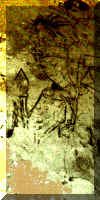St Walstan Mural, St. Andrew’s Church.
 St
Walstan was a rarely depicted saint whose shrine was at Bawburgh, Norwich. The
Cavenham image is the only extant wall painting of the saint and provides one of
the few pieces of evidence for the spread of his cult beyond the immediate
vicinity of Bawburgh
St
Walstan was a rarely depicted saint whose shrine was at Bawburgh, Norwich. The
Cavenham image is the only extant wall painting of the saint and provides one of
the few pieces of evidence for the spread of his cult beyond the immediate
vicinity of Bawburgh .
.
The Legend of St Walstan
The legend of St Walstan began in the last days of Anglo Saxon England. There
are just two primary sources known; Sanctilogium, a Latin manuscript by the
fourteenth - century monk John of Tynemouth and a copy of an ancient triptych
made in 1658, today held in Lambeth Palace and known as English Life.
Some of the common elements taken from these two primary sources relate the
tale of a man of infinite love and charity. The son of Benedict and Blida,
rulers of a small East Anglian Kingdom ,
Walstan left home shortly after his thirteenth birthday taking a job as a farm
hand at Taverham. Here he developed an affinity with the poor and was charitable
to the extreme, giving his clothing and food away.
,
Walstan left home shortly after his thirteenth birthday taking a job as a farm
hand at Taverham. Here he developed an affinity with the poor and was charitable
to the extreme, giving his clothing and food away.
One day the farmer’s wife seeing his meagre clothing gave him shoes and
extra provisions which he promptly gave to a poor man. The farmer’s wife was
irritated and ordered him to take a cart into the forest and fetch a load of
briars, then to tread the them well down with his unshod feet. By a miracle,
Walstan appeared to be treading on rose leaves, the thorns, soft as petals,
emitted a sweet perfume. According to the legend the thorns then turned on the
farmers wife until she had to beg the saint for forgiveness .Throughout
his life animals were brought to him to be healed and people claimed to be cured
through his prayers and ministrations.
.Throughout
his life animals were brought to him to be healed and people claimed to be cured
through his prayers and ministrations.
On 30th May 1016 Walstan was warned of his impeding death and requested that
a priest prepare the ablution as he worked in the field mowing the hay. There
was no water and in answer to Walstan’s prayers a spring appeared at his
knees. After his death his body was laid on a wagon pulled by two white oxon
which appeared to cross the River Wensum as if it were solid ground. Where ever
the oxon stopped a spring would appear. The gathering of followers increased in
numbers as the journey continued, the oxon mounted the short steep hill to the
church and on through the north wall where, according to legend, an opening had
been made by the angels .
.
Fact or Fiction
There is some doubt as to the truth of this legend as his death in 1016 is to
late for Walstan to be a heir to an East Anglian Kingdom and too early to have
been buried by a bishop of Norwich .
Since Walstan was never officially canonised it is difficult to tell whether the
legend is based on fact or fiction.
.
Since Walstan was never officially canonised it is difficult to tell whether the
legend is based on fact or fiction.
The mural in St. Andrew’s is not a narrative image, St Walstan is depicted
as a king and although he holds a scythe to indicate a labourers life the
portrayal has shifted the emphasis to one of power. The kneeling figures are,
though adult, a third the size of Walston, this apparently, is a conventional
method of showing figures of lesser importance.
The Cavenham mural has been dated as between 1465 - 85. Coincidentally in
1457 the church received a rich gift of vestments from Lady Ela Shardelowe of
Bury St. Edmunds .
.